Red Bull Racing uses engines developed by Red Bull Powertrains, based on Honda’s technology. After Honda left F1 in 2021, Red Bull took over engine development themselves.
Formula 1 is a sport where precision engineering, cutting-edge technology, and human skill combine to create some of the fastest and most sophisticated racing machines on the planet. Central to any Formula 1 car’s performance is its engine, more accurately referred to as the “power unit” (PU) in modern F1 terminology. The team that has consistently dominated the sport in recent years, Red Bull Racing, has had a unique and evolving relationship with their engine suppliers, particularly in the turbo-hybrid era of F1.
In this blog post, we will explore the history of Red Bull’s engine partnerships, focusing on the engine they currently use, how they arrived at this point, and what it means for the future of the team.

Contents
History of Red Bull Racing
Red Bull Racing was founded in 2004 after Red Bull, the popular energy drink company, bought the Jaguar Racing team. While initially seen as an outsider in the world of F1, Red Bull quickly grew to become one of the most successful teams, clinching multiple World Constructors’ and Drivers’ Championships. The team’s engine suppliers have played a key role in this success, with various partnerships over the years.
Evolution of Red Bull’s Engine Suppliers
The evolution of Red Bull Racing’s engine suppliers has played a critical role in shaping the team’s path from a mid-tier competitor to a dominant force in Formula 1. Over the years, Red Bull has worked with multiple engine manufacturers, each contributing to different phases of the team’s growth. Here’s a detailed look at how Red Bull’s engine suppliers evolved and their impact on the team’s performance.
1. Cosworth (2005)
Red Bull Racing made its debut in Formula 1 in 2005 after acquiring the Jaguar Racing team. For their first season, the team used Cosworth engines, a well-established name in motorsport, particularly in F1. However, these engines were not on par with the more advanced power units used by other top teams like Ferrari, Renault, and Mercedes.
- Performance: Red Bull’s debut season was largely a learning experience. While the Cosworth engine was reliable, it lacked the power to compete at the front of the grid.
- Notable Moments: Red Bull finished 7th in the Constructors’ Championship, a respectable result for a team in its first season.
Though the team showed promise, they needed a more competitive engine to move up the ranks, leading to a change in supplier after just one season.
2. Ferrari (2006)
In 2006, Red Bull switched to Ferrari engines in a bid to improve their performance. Ferrari’s engine program was well-established, with their own team consistently fighting at the top of the grid.
- Performance: While Ferrari engines provided more power and reliability than Cosworth, Red Bull was still in a development phase. Their chassis design and overall package were not yet capable of challenging for wins or podiums consistently.
- Notable Moments: The team had moments of brilliance but still finished 7th in the Constructors’ Championship.
Ferrari’s engines were a step up, but Red Bull recognized that long-term success would require not just a reliable engine but also a strong technical partnership.
3. Renault (2007–2018)
The most transformative phase in Red Bull Racing’s engine history came with their partnership with Renault, starting in 2007. This collaboration marked Red Bull’s rise to prominence in Formula 1.
V8 Era (2007–2013)
The partnership with Renault peaked during the naturally aspirated V8 engine era. Red Bull’s success during this period was driven by a combination of Renault’s strong engines and the team’s aerodynamic innovations led by famed designer Adrian Newey.
- Performance: Red Bull became the dominant team in F1 from 2010 to 2013. Powered by Renault engines, they won four consecutive World Constructors’ Championships and four World Drivers’ Championships with Sebastian Vettel.
- Notable Moments:
- 2010–2013 Dominance: Red Bull and Renault’s collaboration resulted in 41 race victories between 2010 and 2013. The car’s balance between power and aerodynamics allowed them to outperform rivals, particularly at tracks that favored cornering speed.
Despite their success, the introduction of hybrid engines in 2014 changed the dynamic between the two partners.
Hybrid Era (2014–2018)
In 2014, Formula 1 introduced the hybrid V6 turbo power units, which placed an emphasis on energy recovery systems (ERS) and efficiency. Renault struggled to adapt to the new regulations, and their power units fell behind in performance compared to Mercedes and Ferrari.
- Performance: Red Bull’s performance dropped significantly as Renault’s hybrid engines lacked both power and reliability. The team often criticized Renault publicly for the shortfall, straining their relationship.
- Notable Moments:
- Despite the challenges, Red Bull managed to secure race wins in 2014 and 2016, but they were no longer consistently challenging for titles.
By the end of 2018, the relationship between Red Bull and Renault had deteriorated to the point where Red Bull decided to part ways and seek a new engine partner.
4. Honda (2019–2021)
Red Bull’s next chapter began with Honda in 2019. Honda had a tumultuous history with Formula 1, most notably their troubled partnership with McLaren between 2015 and 2017, which ended prematurely due to a lack of performance. However, Red Bull saw potential in Honda’s power unit and decided to take a chance.
- Performance: Honda made significant improvements after joining forces with Red Bull. By 2019, the team was back to competing for race victories, and by 2020, they were challenging Mercedes at the front.
- Notable Moments:
- 2021 World Championship: In 2021, Red Bull’s Max Verstappen won the World Drivers’ Championship in a dramatic finale, defeating Mercedes’ Lewis Hamilton. This victory was a culmination of Honda’s engine improvements and Red Bull’s relentless pursuit of performance.
However, in 2020, Honda announced their decision to leave Formula 1 at the end of the 2021 season to focus on their goal of achieving carbon neutrality in road car manufacturing.
5. Red Bull Powertrains (2022–Present)
Faced with the imminent departure of Honda, Red Bull made a groundbreaking decision to bring engine development in-house, forming Red Bull Powertrains. Under an agreement with Honda, Red Bull took over the intellectual property of the Honda power units and continued using the engines, now branded as Red Bull Powertrains, starting in the 2022 season.
- Performance: The 2022 season saw Red Bull return to dominance, winning both the Constructors’ and Drivers’ Championships with Max Verstappen. The Red Bull Powertrains engines, based on Honda’s design, have been among the best on the grid, demonstrating both power and reliability.
- Notable Moments:
- Red Bull has continued to win consistently, showing that their new powertrain division is capable of maintaining the team’s position at the top of Formula 1.
This move marked a significant shift in Red Bull’s operations, as they are now a team that controls both the chassis and the power unit—a rare combination in Formula 1.
6. Future: Red Bull and Ford Partnership (2026 Onwards)
Looking ahead to the new engine regulations coming in 2026, Red Bull has announced a major partnership with Ford. Ford, which has a rich history in Formula 1, will return to the sport by collaborating with Red Bull Powertrains to develop next-generation power units.
- Focus: The 2026 regulations will see a greater emphasis on hybrid technology and the use of sustainable synthetic fuels. Red Bull and Ford will work together to design engines that meet these requirements while maintaining the team’s competitive edge.
- Expectations: The Red Bull-Ford partnership is expected to be a formidable combination, with Red Bull’s technical expertise and Ford’s experience in hybrid and electric vehicle technology setting the stage for continued success.

The Engine’s Performance and Specifications
While Formula 1 engines are incredibly complex and heavily regulated, here’s a general overview of what powers Red Bull’s current F1 cars:
- Type: 1.6-liter turbocharged V6 hybrid power unit.
- Turbocharger: Single turbo, designed to maximize performance at high speeds and throttle response.
- Energy Recovery System (ERS): Converts waste heat and kinetic energy into electrical power to assist the internal combustion engine. This is a critical component in modern F1 engines and can deliver an additional 160 horsepower.
- Fuel Efficiency: Formula 1 engines are engineered for both performance and efficiency, with strict fuel flow limits in place.
- Power Output: Modern F1 engines, like Red Bull’s, produce around 1,000 horsepower, combining internal combustion and electric power from the hybrid system.
Frequently Asked Questions
Here are some FAQs about red bull racing’s engine –
1. What engine does Red Bull use in 2024?
Red Bull Racing uses power units developed by Red Bull Powertrains, which are based on Honda’s technology. The power units are built and maintained by Red Bull’s engine division but still carry the legacy of Honda’s successful engines from previous seasons.
2. Why did Red Bull stop using Renault engines?
Red Bull parted ways with Renault after the 2018 season due to ongoing performance and reliability issues. Red Bull felt that Renault’s hybrid engines were not competitive enough against Mercedes and Ferrari, leading to a strained relationship between the two.
3. Why did Honda leave Formula 1?
Honda left Formula 1 at the end of 2021 to focus on their sustainability goals and investments in renewable energy technology. Despite their departure, they agreed to support Red Bull through a transitional period.
4. What is Red Bull Powertrains?
Red Bull Powertrains is Red Bull Racing’s in-house engine development division, established in 2021 to design and develop their own Formula 1 power units. This allows Red Bull to control both the chassis and engine development of their F1 cars.
5. Will Red Bull continue to use Honda engines?
As of 2023, Red Bull is no longer using Honda-branded engines, but they are still using power units based on Honda’s technology. Red Bull Powertrains is now responsible for the development and maintenance of the engines.
Conclusion
Red Bull’s journey with their engines has been filled with ups and downs. From their dominant days with Renault to their struggles in the early hybrid era and their resurgence with Honda, the team has navigated the complex landscape of engine suppliers with remarkable resilience. Now, with their own engine division, Red Bull Powertrains, they are poised to control their own destiny.
The success of Red Bull’s engine program will be one of the most fascinating stories to watch as Formula 1 heads into its next era. With Max Verstappen leading the team and a talented engineering team behind them, Red Bull is well-positioned to remain at the pinnacle of the sport.